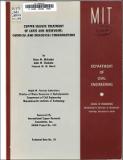Copper Sulfate Treatment of Lakes and Reservoirs: Chemical and Biological Considerations
Author(s)
McKnight, Diane M.; Chisholm, Sallie W.; Morel, Francois M. M.
Download18283758.pdf (3.230Mb)
Metadata
Show full item recordAbstract
Since 1905, copper sulfate has been widely used as a means of controlling nuisance algae in drinking water reservoirs. Reservoir managers, relying on experience, have developed procedures which are generally successful in combating summer blooms of these algae. In some cases, however, treatment programs fail to prevent blooms or may exacerbate the problem. Furthermore, at least two states have issued regulations which effectively prohibit the use of copper in drinking water reservoirs. This report reviews the recent scientific advances in this laboratory and elsewhere on the subject of interactions between copper and lake organisms. The report concludes that algicide treatments are often a necessary part of water quality management and that copper sulfate is still the safest and most effective algicide in most reservoirs. Alternatives to copper, such as organic algicide, are ecological "unknowns" and have determined effects on human health. By contrast, copper, when properly used, is safe for both humans and the environment, as evidenced by nearly eighty years of experience in the field. Part of the report discusses practical techniques for determining the optimal treatment strategy for a given reservoir. This is especially important in lakes or reservoirs that have experienced difficulties in controlling nuisance algae. Using the procedures developed in this laboratory, reservoir managers can design copper treatment programs that will effectively eliminate undesirable algae, with minimal environmental side effects and with a cost effective dosing of copper sulfate.
Description
Sponsored by International Copper Research Association, Inc.
Date issued
1981Publisher
Cambridge, Mass. : Massachusetts Institute of Technology, Dept. of Civil Engineering, Division of Water Resources & Hydrodynamics, Ralph M. Parsons Laboratory
Other identifiers
24
Series/Report no.
R (Massachusetts Institute of Technology. Department of Civil Engineering) ; 81-7.
R ; 81-7Technical note (Ralph M. Parsons Laboratory for Water Resources and Hydrodynamics) ; no. 24.INCRA Project ; no. 252